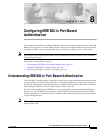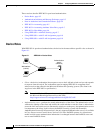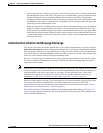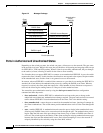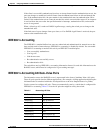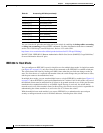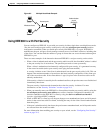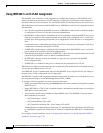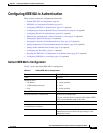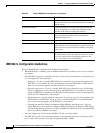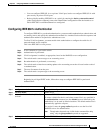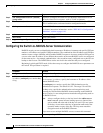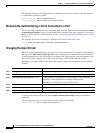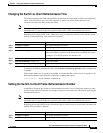
8-8
Cisco ME 3400 Ethernet Access Switch Software Configuration Guide
78-17058-01
Chapter 8 Configuring IEEE 802.1x Port-Based Authentication
Understanding IEEE 802.1x Port-Based Authentication
Using IEEE 802.1x with VLAN Assignment
The RADIUS server sends the VLAN assignment to configure the switch port. The RADIUS server
database maintains the username-to-VLAN mappings, assigning the VLAN based on the username of
the client connected to the switch port. You can use this feature to limit network access for certain users.
When configured on the switch and the RADIUS server, IEEE 802.1x with VLAN assignment has these
characteristics:
• If no VLAN is supplied by the RADIUS server or if IEEE 802.1x authorization is disabled, the port
is configured in its access VLAN after successful authentication.
• If IEEE 802.1x authorization is enabled but the VLAN information from the RADIUS server is not
valid, the port returns to the unauthorized state and remains in the configured access VLAN. This
prevents ports from appearing unexpectedly in an inappropriate VLAN because of a configuration
error.
Configuration errors could include specifying a VLAN for a routed port, a malformed VLAN ID, or
a nonexistent or internal (routed port) VLAN ID.
• If IEEE 802.1x authorization is enabled and all information from the RADIUS server is valid, the
port is placed in the specified VLAN after authentication.
• If the multiple-hosts mode is enabled on an IEEE 802.1x port, all hosts are placed in the same VLAN
(specified by the RADIUS server) as the first authenticated host.
• If IEEE 802.1x and port security are enabled on a port, the port is placed in the RADIUS
server-assigned VLAN.
• If IEEE 802.1x is disabled on the port, it is returned to the configured access VLAN.
When the port is in the force authorized, the force unauthorized, the unauthorized, or the shutdown state,
it is put into the configured access VLAN.
If an IEEE 802.1x port is authenticated and put in the RADIUS server-assigned VLAN, any change to
the port access VLAN configuration does not take effect.
The IEEE 802.1x with VLAN assignment feature is not supported on trunk ports or with dynamic-access
port assignment through a VLAN Membership Policy Server (VMPS).
To configure VLAN assignment you need to perform these tasks:
• Enable AAA authorization by using the network keyword to allow interface configuration from the
RADIUS server.
• Enable IEEE 802.1x. (The VLAN assignment feature is automatically enabled when you configure
IEEE 802.1x on an access port).
• Assign vendor-specific tunnel attributes in the RADIUS server. The RADIUS server must return
these attributes to the switch:
–
[64] Tunnel-Type = VLAN
–
[65] Tunnel-Medium-Type = 802
–
[81] Tunnel-Private-Group-ID = VLAN name or VLAN ID
Attribute[64] must contain the value VLAN (type 13). Attribute[65] must contain the value 802 (type
6). Attribute[81] specifies the VLAN name or VLAN ID assigned to the IEEE 802.1x-authenticated
user.
For examples of tunnel attributes, see the “Configuring the Switch to Use Vendor-Specific RADIUS
Attributes” section on page 7-29.




